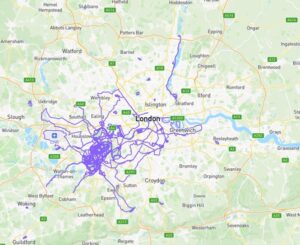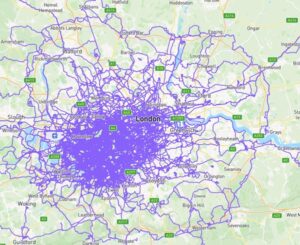I can’t write about my race without first mentioning the 691km women’s world record performance of Allicia Heron or the 638km walked by Sabina Hamaty, which ranks her as the third best female in history behind Allicia and Yolanda Holder. Congratulations to you both.
I wanted to compete in New Zealand’s first ever six-day race because as one of New Zealand’s most prolific six-day athletes of recent years (seven six-day races since 2016) I felt that I needed to be there. I knew that I wouldn’t be fully fit due to injuries that have plagued me all year, but I couldn’t have watched a six-day race happening in NZ and not be a part of it.
A huge thank-you to my wife, Ruth, for allowing me to spend the better part of a month (26 days) away from home (London) for a race that was never going to give me a PB due to my lack of fitness but was something that I had to do.
The reason I needed to be away from home for 26 days was that unlike a six-day race in France, I wasn’t prepared to fly halfway around the world and then compete a day or two later. I wanted to be in New Zealand for a full week before the race. And due to blood clots back in 2019, I wasn’t prepared to fly home immediately after the race with sore and tired legs. I needed another week after the race to recover so as not to risk potential blood clots. Add to that a day and half for travel each way, plus some additional time to get the cheapest available flights, and I was out of the UK for 26 days.
Pre-race:
As soon as I mentioned the possibility of competing in a six-day race in New Zealand, my father (84 years young) volunteered to be my support crew for the race. This made the race extra special for me – a chance for a road-trip and a bit of an adventure with Dad.
Dad owns a medium sized campervan which we took down to the race, driving down from Wellington to Christchurch during the three days before the race (Friday, the 3+ hour ferry trip from Wellington to Picton and a short drive down to stay with friends in Blenheim. Saturday, drive down to Kiakoura where we went to a local pub to watch the All Blacks beat Australia in the rugby. Sunday, drive the rest of the way to Christchurch).
Although my fitness was sub-par due to multiple injury problems throughout the year, I was still hoping for a reasonable result and insisted on staying in motel accommodation in Kiakoura and in Christchurch the night before the race (rather than sleeping in the campervan), but even with a bed to sleep in I had two restless night’s sleep. Not an ideal build-up. I also had a chesty cough which I was ignoring.
The highlight before the race was meeting other competitors (mostly Australians) and their support crews in a local pub on the Sunday afternoon (Race start 2pm Monday). There were five walkers entered in the race – four Australians plus myself – and 20 runners. I knew all four Australian walkers by reputation but had never met any of them:
- David Billett – Australian six-day record holder at 625km
- Sabina Hamaty – Australian 48 hour and six-day women’s record holder (623km)
- Joffrid Mackett – Australian 48 hour record holder (295km – 17km better than my best) making his six-day debut
- Allicia Heron – former Australian women’s 48 hour record holder, also making her six-day debut
To be honest, even in my unfit state, I thought I would comfortably follow the All Blacks and ‘beat the Australians’, something that The Press quoted me as saying when they interviewed me before the race.
And whilst David was talking up his prospects at the pre-race meet-up, I learned that both David and Joffrid had also struggled with injury in the lead-up to the race. And I wasn’t expecting the phenomenal performances that Allicia and Sabina delivered. Maybe I was a little over-confident.
My best six-day result was (is) 86km better than David’s best, and was 88km better than Sabina’s. Even with major blister problems at 6 Jours de France last year, I had walked 671km (my second-best distance, and world M55 age group record), so I thought I should be capable of walking about 650km which I thought would be good enough for the win.
Afterall, six-day racing is more about mental strength than physical, and I was confident in my mental strength and the fact that I was much more experienced at six-day racing than the other four walkers.
As well as the walkers, there were 20 runners – one from Japan, one from Romania, a few from NZ, but mostly Australians. I knew many of the names, but this was my first opportunity to meet them in person.
Dad also found this Sunday afternoon meet-up to be a great opportunity to meet some of the other support crews as well as the race organisers – people that he would be spending a lot of time with over the coming week.
And it was at this meet-up that I realised that this race would be completely different to all my other six-day races. The difference, everyone spoke English!
The course:
The race was held in Hagley Park, Christchurch on a 2.8122km circuit. Compared with my previous seven six-day races, all of which have been at the 6 Jours de France in either Privas (2016, 17 and 18) or Vallon Pont d’Arc (2022 to 2025), this was a long circuit. The French six-day races have all been on circuits of about 1.1km.
It was also the first time that I have raced a six-day in a public park. This took a little bit of getting used to on the first morning when we found ourselves competing for space with commuters on bikes, scooters, and on foot. Being in a public space added variety though – seeing people that knew nothing about the race on day 1 and 2, who came back every day to check on our progress. Watching a young child learning to ride his bike at about 5pm every afternoon and watching other activities taking place in the park throughout the week all helped pass the time.
Race headquarters and the start/finish of each lap was beside the Hagley Park golf club which the race organisers had use of for the whole week of the race. This worked out really well when the weather turned from ‘not good’ to bad after the first 24 hours, and to horrible in the final 24 hours. Most athletes found themselves eating meals in the clubrooms and using the warm indoors to warm up and dry out on a regular basis throughout the race.
I have to say that the hot meals provided by the race organisers were excellent. As well as three hot meals per day, toasted sandwiches and other treats in the middle of the night were much appreciated.
Next to the clubrooms was a fenced off area whether athletes’ tents were located. This was the first time I’ve slept in a tent during a six-day race since Privas. At Vallon we have the luxury of a cabin beside the track. But thanks to a well-oiled support crew (Dad) my tent was always ready for me when it was time for a sleep, and I was able to stay warm by wearing multiple layers of clothes in my sleeping bag which was wrapped in a Duvee with additional blankets underneath and on top. As mentioned above, the weather wasn’t great and at night the temperatures approached zero. During the day, they rarely made double digits.
The course comprised of a small loop which was the finish and start of each lap (thick pink line in the diagram below), a short out and back section (which was a great opportunity to see other athletes) and a big loop.
I still don’t know whether or not I liked the big loop. There was definitely variety but there was only one toilet on the big loop, meaning that after passing the toilet you had to hold on for about 2.3km until the end of the lap. As I expected, this became a problem at times later in the race when my bladder became overactive as it tends to do when I’m exhausted. Fortunately, there were plenty of trees to hide behind and the constant rain over the last few days kept the public away saving me from any embarrassing moments.
After the toilets there was a short stretch that had a heavy camber, sloping off to the right. At the start of the race this part of the track seemed relatively flat, but as with the three small undulations (of no more than a metre) on the course, by day six the camber felt quite steep. This was the worst part of the course. The rest was smooth tarmac.
When we reached the far corner of the course, it was like we were steeping into a different (colder) climate. Several of us commented that the moment we hit the river the temperature dropped. During the day it was quite nice walking alongside the gently flowing river and at night the streetlights reflected off the water. Sometimes, when I was struggling, I would ‘race’ bits of driftwood that were floating down the river.
This area of the course was the darkest section, and having a head-torch at night was helpful, although not a necessity. It was, however, the only section where I had any hallucinations. I can’t remember whether this was only on the last night or the last two nights. The hallucinations were only what I refer to as ‘entry level hallucinations’. Mainly trees in huge white pot-plant holders. A beautiful pussycat in the sky (just branches of the trees) and one scary moment when the path jumped up in front of me and I had to stop abruptly to avoid walking into the black wall immediately in front of me.
After we turned off the river and back towards the end of each lap we were on my favourite section of the course. The path was wide, maybe as wide as a two-lane road, and when I was tired at night, I found that I could close my eyes and walk straight down the middle, opening one eye every 20 seconds or so just to check that I wasn’t veering off to one side. I don’t think I ‘slept’ as such, but I’ve often found that closing my eyes for short micro-naps helps me when I’m struggling with sleep deprivation.
Another thing worth mentioning is that for us walkers, this was a judged race. To my knowledge, the first time a six-day walking race outside of France has had racewalking judges. Having judges onsite validates the fact that walkers were actually walking, although in all walking races other walkers will also monitor each other to ensure that those athletes competing as walkers are actually walking. A big thank you to Phillip Sharp (NZ) and Tim Erickson (Australia) for judging this event.
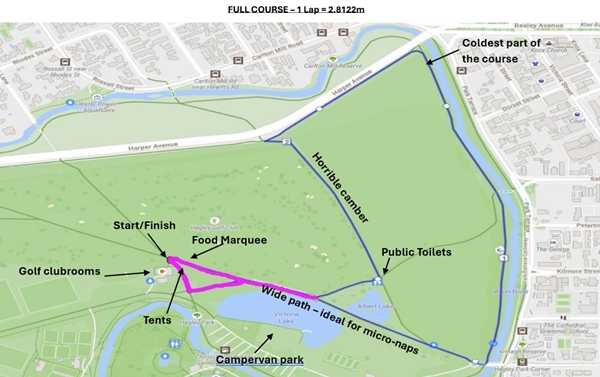
The race:
The race started at 2pm on Monday (29th September) in what turned out to be the best weather of the week – sunny with a gentle breeze.
A six-day race is not really a race. At least not for the first few days. Anything can happen during 144 hours and it is important to focus on yourself – walking a steady pace and managing nutrition and sleep – for at least the first three or four days.
If you are in a position to ‘race’ during the last few days, that is the time to focus on how other competitors are doing. Until then, just focus on what you can control – which is you.
Easier said than done though. David shot off at the start and had lapped me before I completed my 8th lap! And Allicia had lapped me before I completed my 11th lap.
David had plans to walk over 100 miles (161km) in the first 24 hours. I told the others that I would be happy with 150km but there is always something special about walking 100 miles in under 24 hours (24 of my previous 48 100 milers have been sub-24 hours) and my early planned pace of 7km per hour would take me close to that with the expected slow-down over night. At four hours I was exactly on pace and feeling comfortable.
My nutrition plan was to consume about 100 calories/25 grams of carbohydrate every 20 minutes for the first 24 hours and given that I was lapping at 24 minutes per lap that meant collecting either one or two ‘eats’ from Dad at the end of each lap and carrying them until the timer on my watch told me it was time to eat.
This worked well. Dad quickly got into a routine of meeting me outside the food marquee with my food box each time I completed a lap. I would grab whatever I wanted and keep on walking. My main nutrition outside of the three daily meals supplied by the race organisers was going to be sports supplements – a range of carbohydrate chews and drinks which Dad had mixed up for me and poured into 125ml bottles. The carb drinks I like to consume are double the normal concentration – a combination of either Tailwind or SiS powder mixed with plain maltodextrin to give me the 100 calories/25 grabs of carbs per bottle. As and when necessary, I would also drink pure water but in training over the last two years I have found that I can happily tolerate 300 calories/75 grams of carbs per hour for the better part of a day.
For the first 72 hours I was recording everything I consumed in an app I had created using Google Sheets. My analysis shows that on day one I consumed 5,600 calories/1,185 grams of carbohydrate. There was some guestimation in that analysis given that I was also eating food supplied by the race organisers for dinner, breakfast and lunch, but this was a reasonable estimate and with the high calorie count in the early stages of the race, I hoped this would set me up well for later on when I didn’t feel like eating as much.
And after the first day I was planning on reducing my calorie/carb intake to where I was still consuming 100 calories/25 grams but only per lap and not per 20 minutes. I was also planning on switching to eating more real food – fruit, biscuits, cereal bars – and using the sports nutrition to top up my calories.
I walked well for the first 20 laps (56km) averaging 7km/hour with only one short toilet break, and told Dad to go to bed at around 10pm figuring that I would have my usual slow-down over night but I didn’t really need his support on a lap-by-lap basis through the night. It was more important that he got adequate sleep, especially in the early stages of the race.
Overnight though, I started to experience some minor diarrhoea and had a few stops in the toilets and behind trees on the course. It was nothing serious and I still felt OK, but my average lap times slowed overnight and didn’t recover when daylight arrived.
After 21 ½ hours I had completed 138km and was actually leading the walkers. Only Sabina and myself had walked through the night, and whilst I could have continued through to 2pm and possibly completed 100 miles in under 24 hours, I was feeling tired. My last few laps had taken 30 minutes and I decided to have a short sleep.
I always find it hard to fall asleep when I stop the first time during a six-day race. I’m tired, but not exhausted, and going from a state of moving, even at only 5 ½km per hour, to being asleep isn’t easy.
For Christmas, Ruth gave me some noise cancelling headphones which I hoped would drown out any background noise, and I also had a black-out eye mask which I hoped would help me sleep during the day. I didn’t manage to fall asleep during that first break, but it was good to lie down and rest. I was off the track for about an hour and 20 minutes that first time but only managed to walk another four laps before deciding I needed another sleep.
In the first 24 hours I completed about 51 ½ laps for a day one total of 144.7km.
Day two is always the hardest in a six-day race. Your body is struggling to adapt to what you are making it do, and your mind is feeling the pressure and wondering how on earth it can keep pushing the body for another five days.
We had occasional rain through the first night and the rain was now becoming more regular. Even although the weather forecast had looked good when I left London almost two weeks earlier, I had a good selection of wet weather gear and had purchased two additional pair of waterproof socks when we arrived in Christchurch. I was able to stay dry which is the most important thing. If your clothes get wet, you get cold, and when you get cold your performance deteriorates rapidly.
I can’t remember, but I think I may have used the rain as an excuse to have my second sleep so early (24 ¾ hours into the race). This time I know that I slept. I was off the track for two hours in total (for a 45 minute sleep) but when I resumed walking I just wasn’t feeling good. The cold wind was getting to me, and I was coughing a lot.
It was about 5pm when I resumed walking. I managed a few 26 to 28 minute laps but eventually they slowed to 30 and 31 minutes and, having sent Dad off to bed at around 10pm I eventually decided I needed another sleep at midnight and asked one of the race organisers to wake me in an hour.
That sleep did the trick and I was able to walk relatively well for the next three hours before I crashed again, dawdling around the course with back-to-back 35 minute laps, struggling to stay awake.
I went back into my tent for another sleep and sent Dad a txt message asking him to wake me at 7am. By now, the weather had deteriorated to the stage where I was eating all my main meals inside the golf clubrooms (eating hot meals outdoors when it is cold doesn’t work) and so after waking I joined Dad for breakfast in the warmth of the clubrooms, dealt with some minor blistering, and then finally headed out on to the track again after a 2 ½ hour break.
I took another short indoor break for lunch at around 12 noon and finished day two (48 hours) with 236km.
In the first 48 hours I had spent 9 ½ hours off the track! That was 50% of my budget for the whole race, and in that time I had had an estimated three hours sleep, which was on target. I was just wasting way too much time being unproductive.
Looking at the results while writing this, at 48 hours I was 25km behind Sabina (261km) who was walking a very consistent pace with only a few short breaks to date. Allicia was on 247km, and David and Joffrid were well behind me.
I had only managed 91.5km in day 2. Well below the 100km plus that I would normally expect, but I was relatively happy with this given my lack of fitness. I thought that I would recover during day 3 and probably end up with around 630km at the end of the race. I wasn’t thinking about where that might place me.
If I thought day two’s mileage was sub-par though, I was in for a surprise on day 3. I just wasn’t firing. I had another sleep and break for dinner late afternoon on the Wednesday and averaged just 32 minutes per lap through until 5am Thursday (63 hours) when I decided I needed another sleep.
Including breakfast in the clubrooms, I was off the track for over three hours. This was becoming a relative ‘holiday’ and not a ‘race’. I was taking way too much rest but even with the rest I was really struggling. My chesty cough was bad, and I just wasn’t feeling myself.
My day 3 mileage was only 76km – 312km for 72 hours. I was still ahead of David and Joffrid and it was becoming obvious that we were in for an exciting remaining three days in the women’s race. At 72 hours Sabina was on 371km, and Allicia was only two laps behind on 365km. 353km was approximate world record pace based on the 53% rule (53% of six-day mileage is covered in the first 72 hours) and using that same rule it was possible that we could see the first 700km performance by a female!
I messaged Yolanda, current female world record holder, to alert her in case she wasn’t tracking the race, and Ivo (men’s world record holder) was also messaging me – excited at the prospect of a women walking 700km.
The highlight of day 4 for me was always going to be a visit from my son, Mathew, and his fiancée and stepdaughter, Rachel and Ella. They arrived in Christchurch that morning for a short holiday and had promised to bring fish and chips for tea. Given that I wasn’t having a great race I decided I would stop when they arrived, and we would have a picnic dinner sitting at the tables outside the golf clubrooms – although I was becoming concerned about out ability to do that given that rain was threatening again.
Between lunchtime and their arrival, my lap times were ridiculous – averaging 40 minutes. I felt terrible and was just hanging on waiting for them to arrive. I spent about an hour with them, and had a good feed of fish and chips (NZ fish and chips are the best!) before heading back on to the track only to find that now I was unable to complete a lap in under 45 minutes!
Something was very wrong and at 8pm I told Dad that I was going to bed and would sleep until I felt better. There was no need for him to wake me.
I woke at 9, 10 and 11pm needing the toilet. Each time I felt absolutely terrible.
The difference between a nice warm cabin at 6 Jours de France and a tent at the NZ 6-day was that in France I simply needed to roll out of a comfortable bed and I was one metre from the toilet. In this race, every time I needed the toilet, I had to put my shoes on and walk about 20 meters from my tent to the toilets on the far side of the clubrooms. Not ideal, but it was the same for everyone.
After that 11pm pee I slept for 5 ½ hours solid, and when I woke to go to the loo again at 4:30am it was like I was a different person. I felt fantastic!
I sent Dad a txt:
I was delirious overnight.
Just woke up.
Feeling better but it’s raining.
Going back to sleep for a bit.
But I think I’m going to have a better day today.
I sent the same txt to Ruth then put my phone back on airplane mode and went back to sleep again.
Dad woke me at 8:30am. I had slept for 12 ½ hours! I had managed to sweat out whatever bug I was struggling with, and I was ready to move again. I had breakfast before resuming walking, but once back on the track, I was on fire!
My lap time for that 119th lap was 13 hours and 20 minutes!
In the 24 hours up to and including that 13:20 lap, I had walked just 12 laps. Less than 34km!
But now I was lapping in 30 minutes, then 29 minutes, then 28 followed by 27:01 – my fastest lap in almost three days!
Supporters, organisers and other athletes all commented on how much better I looked. I joked that I was a twin, and I had sent my other twin home 😊
Nearing lunchtime on the Friday it was time for my biggest surprise of the race. My mother and stepfather, who live in Waikanae (60km north of Wellington) were on the side of the track at the completion of the lap. Before I completed the lap, Mathew ran down to meet me. He told me he had a big surprise for me, and in my exhausted semi-delirious state I wondered what Mathew could have as a surprise today that he couldn’t tell me when I saw him yesterday? I told myself that the baby (I forgot to say that Rachel and Mat are expecting a baby next April) must have been born. What else could it be?
So, I was totally shocked to see Mum and Chris. It really made my day. I completed one more lap and then took a break in the clubrooms for lunch so that I could talk to them. Also, I’m glad the baby hadn’t been born overnight. It would have been a little too premature!
I was off the track for a little over an hour, but on returning I strung together 11 laps (31km) in the next five hours at an average of 27:22 and a fastest lap of 26:11. Isn’t it amazing what a positive attitude can do? And the fact that I had shaken off whatever bug I had been struggling with, and had also had a long sleep.
Along the way, I completed day 4 (which had included the 12 ½ hour sleep) with a total distance of 354km. My day 4 total was my worst in all my six-day races (except for Vallon in May this year when I only walked three days in total due to injury) at 42km – just short of a marathon.
Alicia was leading the walkers comfortably with 496km. She passed 500km in a shade under 4 days and 2 hours. 32 minutes faster than my best 500km time, from 2022 when I walked 711km in six days. It appeared that not only was Allicia on track to become the first female to walk 700km in six days, but potentially she could beat my best and become the fourth best six-day walker in modern racewalking history!
I was excited to see what she could do, but at the same time I was secretly hoping she wouldn’t beat my best.
Sabina wasn’t far behind on 461km. It could come down to who needed the least sleep over the last two days and I told Sabina not to give up. Anything could happen.
And David was now 20km ahead of me on 374km. Call it being over-confident, but from the time I entered the race, even with all my injury problems, I had always assumed that I would win the walkers division of the race and being the first six-day race in New Zealand I had pictured my name as the NZ Allcomers record holder.
This wouldn’t happen now. Allicia or possibly Sabina would take the overall record, and even the possibility of the NZ Men’s allcomers record was in doubt. Except, I had a trump card up my sleeve. I had just slept for 12 ½ hours mid-race and was confident that if I needed to, I could complete the race with very little, maybe no sleep if necessary.
After a short break for dinner on Friday night, and another chat with Mum, Chris and Dad, I walked relatively well through the night, averaging 31 ½ minutes per lap. I walked a few laps with both Allicia and then with Sabina.
The last two nights of the race was where I realised how much ‘easier’ it is walking a race which comprises predominately of English speaking athletes compared to the six-day races in France where there are only a handful of runner/walkers who speak good English, and even less that happen to be walking at the same pace as you when you most need someone to talk to.
I think we all agreed that walking and talking helped get us through the nights. It definitely helps pass the time and helps with staying awake.
I was feeling strong most of the night, especially when walking with others, but at around 3:30am I decided that I did need another sleep. I asked Kerryn (one of the organisers) to wake me in 45 minute. Looking at messenger on my phone now, I see that it was 35 minutes later that I messaged her and asked to delay my wake-up call to 5:15. I was shivering and thought I hadn’t been to sleep yet. It turns out that I had been asleep, and I could have resumed the race after just 30 minutes sleep, but instead I wrapped myself in more blankets and slept through until I was woken at 5:15.
I was back on the track soon after waking and walked five laps at 27:30 pace before breaking for breakfast.
I haven’t mentioned Dad for a while. He was doing an exceptional job. Waking me, feeding me, organising my tent. A good support crew can easily save an athlete an hour per day (over 30 kilometres during the entire six days) and Dad was doing just that.
Thanks Dad!
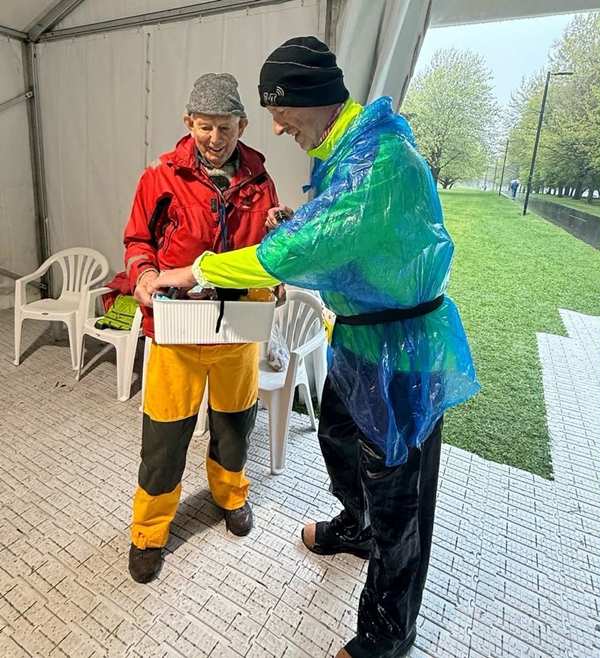
I don’t know why, but nearing the end of day five, according to the lap times I had two breaks of about 30 minutes on consecutive laps – i.e. two consecutive laps of just over an hour each. One would have been for breakfast. I don’t remember the second break. I know that the organisers have scrutinised the results to ensure accuracy, so I don’t doubt the results. I just don’t remember taking a second break.
By the end of day 5 I had reached 464.5km, 110.5km for the day. That’s more like it!
Allicia was on 590km, Sabina 545km, and David was slightly behind me on 458km.
I had two laps on David. Not a lot, but I figured that I could manage that. I wouldn’t take a break unless he took a break. I wouldn’t sleep unless he slept. As far as I was concerned, the race for first male walker was on!
That said, just before dinner on the Saturday night, I took a five-minute powernap. I was tired but I knew I didn’t have time to sleep. Five minutes is enough to get rid of the extreme tiredness feeling. And when having a short powernap like this, you don’t need to waste time taking shoes off, putting them back on, etc. You are off the track, lying down, asleep within seconds, woken up (by Dad) and back on the track. At a maximum, maybe five minutes of additional unproductive time on top of the time spent asleep.
On returning to the track I found I was now three laps up on David and I asked him if he was going to take a break for dinner. His reply was something along the lines of “I will if you will”.
So, we both took a break for dinner. I did some quick blister repairs and ate while fixing my feet – probably not very hygienic. David was at a different table to me and when I had sorted my blisters, I headed out the door towards the toilet in the hope that if he noticed me leaving, he would just think I was going to the loo and would be back soon.
I then headed on to the track and based on what I can see from the lap times, I put about 12 minutes on him before he resumed walking.
In the end, that little bit of gameplay was unnecessary, but it made me feel good and I then proceeded to walk through the night at what I thought was a good pace, but I now see looking at the lap times that I was only averaging 36 ½ minutes per lap.
The lead runner, Dale Paul, had injured his Achilles tendon on day 5 and was now just walking with the intention of getting through to 700km. I walked with him for about 2 ½ to 3 hours during the night. To pass the time we played 20 questions. Questions such as “what is your favourite shoe”, “what other races have you done”, etc. Once again, one of the big benefits of this six-day race versus the races I’ve done in France – the opportunity to walk and talk with other English speaking athletes.
And while I think about it, another benefit of competing in New Zealand was the number of friends who came to watch at various stages during the race – if you were one of them, thanks.
Dad was awake early and we stopped at around 7am for breakfast. I had eight laps on David, and the weather was anything but pleasant – cold wind and rain – so I decided I had plenty of time for a leisurely breakfast and some more blister repair. By this stage ‘blister repair’ was mainly related to changing from wet socks to dry and perhaps draining and taping any new blisters. The blistering wasn’t actually as bad as I have experienced in other races but keeping an eye on them at each stop was important.
I was almost ready to resume walking when Kerryn (or maybe it was Gus or one of the other race volunteers) came inside to advise that Allicia was about to break the women’s world six-day walking record (currently 665km) and asked us all to go outside and cheer for her when she completed her lap.
It was an emotional moment, and I was grateful to witness it. Allicia decided to take a break and came inside the clubrooms which gave me the opportunity to facilitate a call from Yolanda in which she congratulated Allicia. It was a really nice touch – the former world record holder congratulating the new record holder.
Eventually, I returned to the track for the final five hours of the race. I walked 10 laps plus a final 791 metres in the last six minutes of the race. That’s 7:45/km pace or 22 minute lap pace – faster than I had walked at any time during the race. It just shows how this race is more mental than physical and when the end is in sight it is so easy to pick up the pace.
Our final distances were:
- Allicia Heron – 691.801km
New female world record, Australian overall world record, W40 age group world record, 8th best athlete in history behind the seven men (including me) who are members of the exclusive 700km club.
Also the inaugural NZ allcomers record. - Sabina Hamaty – 638.369km
Australian W55 record and 3rd best female in history behind Allicia and Yolanda Holder.
New German overall record thanks to her dual nationality. - Richard McChesney – 571.668km
Thanks to my recent UK citizenship, this is a new GBR men’s record beating the 501km walked by Tony Mackintosh in Privas in 2018, but is 39km short of Sandra Brown’s overall GBR record.
It’s a little bit ironic that as a New Zealand born athlete I returned to NZ to set the GBR record.
Also the inaugural NZ men’s allcomers record. - David Billett – 560.670km
- Joffrid Mackett – 434.186km
Interestingly, my injury problems were OK during the race. The foot that I injured in Vallon in May was almost 100% OK. I only felt it a couple times when my foot landed at a strange angle. And my left glute which I injured in the gym when I couldn’t walk was OK until a couple days after the race, and is now painful every day once again. Is it mind over matter? I don’t know.
Thanks Dad:
As I have said, a good support crew will save an athlete at least an hour per day during a six-day race, and Dad definitely did this for me. Going into the race he was concerned that he wouldn’t be as good as Sarah, my support crew for my last four six-day races plus a few other races, but he was phenomenal.
And both during and after the race I received great feedback from the race organisers, other support crews, and even other athletes about Dad. He was absolutely fantastic!
Analysis:
As always, I have done some analysis of my race. Some interesting (to me anyway) facts:
- I wore a Continuous Blood Glucose Monitor throughout the race as well as for a few days before and after. I wanted to see whether or not my glucose levels were too high or too low at times during the race, and interestingly, while they were marginally higher than in the days leading up to the race, they were no more volatile and the peaks were not as high as I expected.
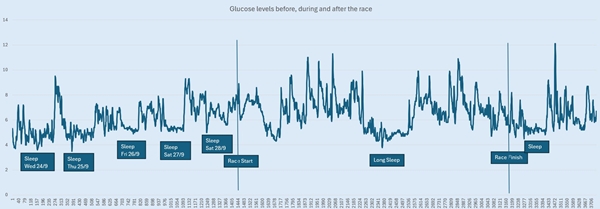
- Over the last 18 months I have been training my gut to absorb higher volumes and concentrations of carbohydrate, and I created a simple app to record all my nutrition during the phone – only problem being that I couldn’t use the phone/app when it was raining. I recorded my nutrition for the first 72 hours of the race:
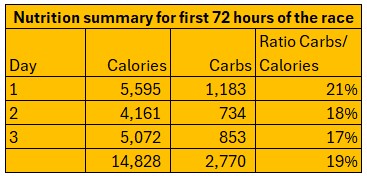
I don’t know why the drop off on day 2. Possibly related to the amount of sleep/downtime I had. - In the app I also recorded all my toilet breaks (as you do) because if it was hot and I didn’t pee for a long time, the app would warn me to drink more – not applicable to this race. And if I was peeing too many times, maybe I needed to reduce my fluid intake.
I find that I pee way too many times when walking in training and racing, and in the first 72 hours of the race I stopped 36 times. I didn’t record the rest of the race, and to be honest, I don’t know whether this is a normal number of times in cold, wet weather or not.
I think an average of once every two hours is pretty much average for me in a long race. - I’m always looking for where I won, and in the last 48 hours of the race I completed more laps than anyone else – runners and walkers. One more lap than overall race winner, Nico. In fairness, I slept over half of day 4 and therefore needed significantly less sleep than anyone else on days 5 and 6.
- I was the heaviest I have ever been going into a six-day race. I started tracking my weight in 2017 as per the graph below.
When I walked by PB in 2022 I was 82kg at the start. At the start of this race I was 91kg!
That is a lot of extra weight to be carrying around for six days, and I wonder if the extra weight has contributed to my injury issues. The problem is that I just can’t get back down to my old weight.
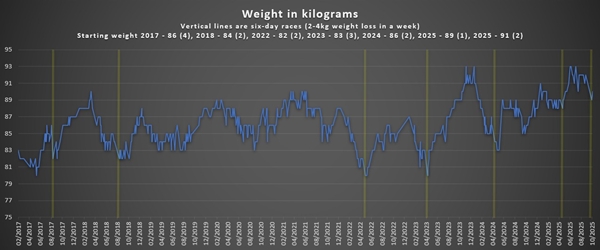
What’s next:
I usually finish my race reports with what I’m planning next.
But at the moment I have no idea.
I’m highly unlikely to do another six-day race next year. Each six-day race requires about two weeks away from work, and I have already advised the organisers of 6 Jours de France that I won’t be competing next year because I don’t want to train through a UK winter.
And I have some injury problems that I need to completely recover from before I resume any serious training. 2025 has been my worst year for injury since I first started walking in 2012.
So, I don’t know what’s next.
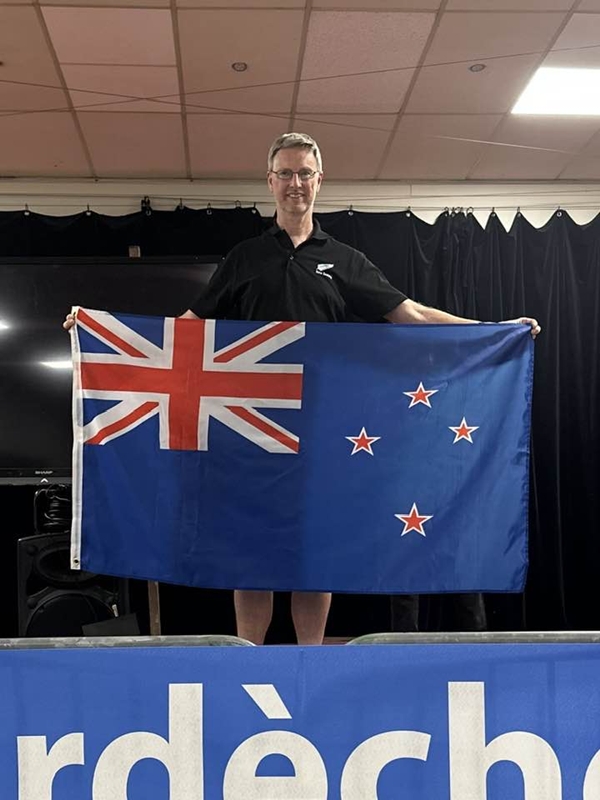
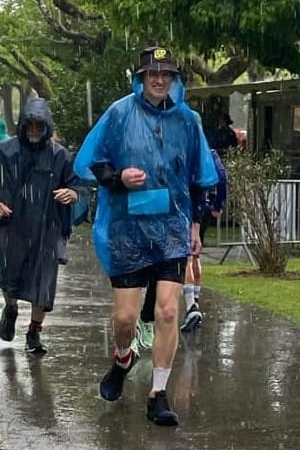

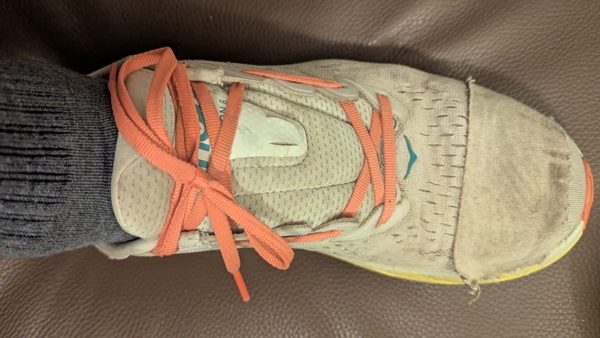
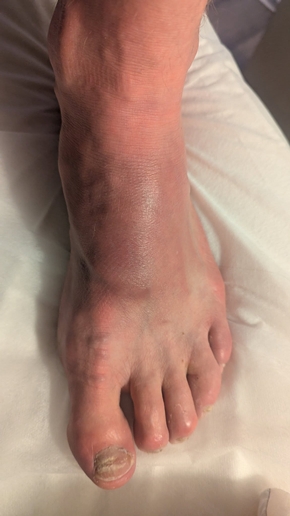
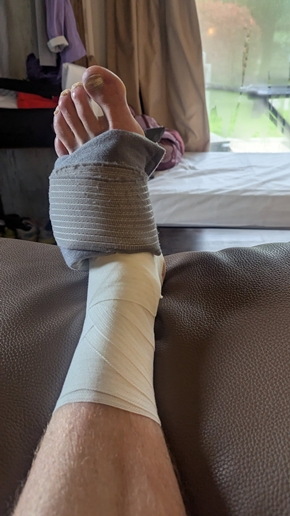
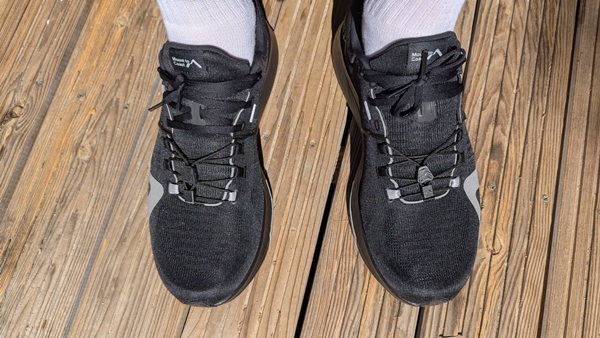
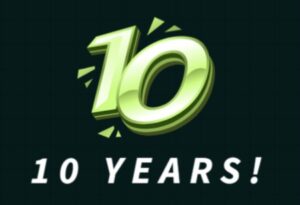 As well as being the start of a new year, today marks ten years since I started this blog so I thought I would have a look back at what I have achieved and some of the experiences I have had over the last ten years.
As well as being the start of a new year, today marks ten years since I started this blog so I thought I would have a look back at what I have achieved and some of the experiences I have had over the last ten years.
